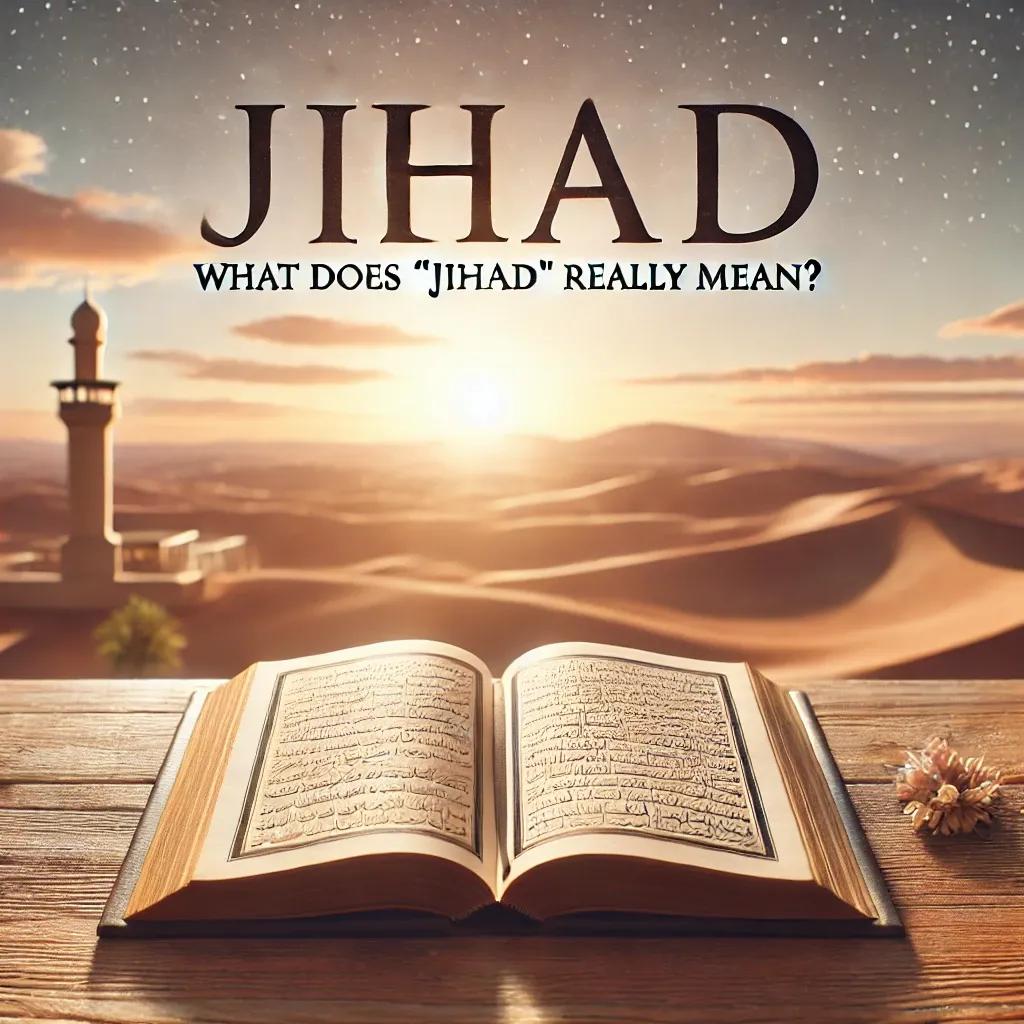

By Dr. Tim Orr
When we hear the word jihad today, it immediately sparks strong emotions. For some, it conjures up images of terrorism and holy war. For others, eager to offer a more positive narrative, it is simply a peaceful "inner struggle" for self-improvement. These impressions contain grains of truth, but neither captures the full historical reality. David Cook’s landmark book Understanding Jihad (2005) provides something increasingly rare in our soundbite-driven world: a careful, honest, and historically grounded exploration of what jihad has meant for Muslims over the centuries (Cook, 2005). Drawing heavily on the Qur'an, early Islamic biographies, and classical legal thought, Cook shows that while jihad is a rich and evolving concept, it has been primarily understood throughout Islamic history as physical combat in the cause of Islam. By helping us step into the worldview of early Muslims and tracing how that vision was reinterpreted over time, Cook equips us to see through modern misunderstandings—whether they minimize or exaggerate the nature of jihad.
Jihad in Early Islam: War as a Divine Mandate
Cook begins by examining the life of Muhammad himself. Unlike some modern portrayals that suggest Muhammad’s mission was primarily about moral reform or spiritual enlightenment, early Muslim sources present him as a prophet who saw military struggle as integral to the growth of his religious community. According to the Qur'an, once the Muslim community gained strength in Medina, Muhammad received revelations commanding fighting against the "unbelievers" (Cook, 2005, pp. 11–17). Verses such as Surah 9:5 ("slay the pagans wherever you find them") and Surah 2:190 ("fight in the cause of God") demonstrate that warfare was not just permissible; it was seen as a divine obligation.
Cook vividly illustrates this by recounting the Battle of Badr (624 CE), the first major military victory for the Muslims against the Meccans. This event was not merely a political success; it was interpreted as a miraculous sign of divine favor. In Surah 8 (Al-Anfal), the Qur'an describes how God sent down angels to assist the Muslim forces (Cook, 2005, p. 14). Badr became the blueprint for later Muslim understandings of jihad—a sacred, God-ordained duty involving real fighting, not merely a spiritual metaphor. Importantly, the nature of this fighting was not merely defensive. Early Islamic jihad was expansionist, aimed at extending Islamic political control beyond Arabia. Jihad was framed to secure God's rule over the earth. As Cook explains, early Muslim jurists taught that the normal state of relations between Muslims and non-Muslims was not peace but latent hostility, interrupted only temporarily by truces when necessary (Cook, 2005, pp. 18–21). This was the legal and theological scaffolding upon which later Islamic empires would build their military campaigns.
The Spiritual Jihad Narrative: A Later Sufi Development
One of the most illuminating parts of Cook’s book is his detailed treatment of the "greater jihad" versus "lesser jihad" distinction. Many have heard the idea that the real jihad is the inner spiritual struggle to become a better person, with physical fighting only a minor, regrettable aspect. This idea sounds comforting, and in today’s politically charged environment, it is often promoted by those wishing to defend Islam from being equated with violence. However, Cook shows that historically, this was not how early or classical Muslims understood jihad. The famous saying about the "greater jihad" being internal comes from a weak hadith, not from the Qur'an or the reliable sayings of Muhammad. The most authoritative Islamic sources consistently present military jihad as the primary meaning (Cook, 2005, pp. 32–36).
Cook provides an important example: the emphasis on warfare is overwhelming when examining the major early collections of hadith, such as Sahih al-Bukhari and Sahih Muslim. Sahih al-Bukhari contains an entire "Book of Jihad" (Kitab al-Jihad), filled with instructions about killing enemy fighters, raiding enemy territory, and taking spoils of war, including captives (Cook, 2005, p. 34). These collections glorify martyrdom and promise immediate afterlife rewards for those who die in battle, contrasting sharply with the Qur'an’s more cautious approach to salvation. One hadith states that paradise is guaranteed for the martyr "with the first drop of his blood" (Cook, 2005, p. 35).
Furthermore, Cook discusses how the treatment of women captives was permitted under rules that seem barbaric by today's standards. Captured women could be taken as part of the spoils of war (ghanima) and enslaved, with Islamic law permitting their owners to have sexual relations with them (Cook, 2005, pp. 35–36). Qur'anic verses like Surah 4:24 are cited in support. The hadith collections even record debates among Muhammad’s companions about the timing of sexual relations with female captives—whether it was better to wait until after purification or proceed immediately upon capture (Cook, 2005, p. 36). Shockingly to modern readers, these were mainstream legal and religious discussions.
This early hadith material anchors jihad squarely in the realm of warfare. It was not presented as an allegory for self-improvement. It was bloody, literal, and commanded without sentimentality. Human dignity—especially for non-Muslim women—was sacrificed under the logic of sacred warfare. It was only centuries later—particularly among Sufi mystics—that the "inner struggle" interpretation became prominent. Even then, it usually supplemented rather than replaced the physical understanding of jihad. Cook points to Al-Ghazali, who emphasized battling the ego (nafs) but still praised military jihad (Cook, 2005, p. 37).
Institutionalized Jihad: The Classical Islamic Framework
As Islam expanded beyond Arabia, Muslim scholars grappled with complex realities: how to treat conquered peoples, govern warfare, and fit jihad into the life of a stable Muslim community. Cook explores how classical Islamic law (fiqh) developed the Dar al-Islam ("House of Islam") and Dar al-Harb ("House of War") framework (Cook, 2005, pp. 41–50). In this view, the world was divided into Islamic territories and those yet to be brought under Islamic rule. Peace treaties were acceptable, but only as temporary measures.
Cook highlights the 11th-century jurist Al-Mawardi, who codified that the caliph must wage jihad at least once a year to keep the community faithful (Cook, 2005, p. 47). Warfare was not random—it was state-driven and religiously legitimated. Classical scholars like al-Shafi'i, Al-Mawardi, and Ibn Taymiyyah viewed jihad as a religious duty tied to Islamic governance. Even taxation structures like the jizya (poll tax on non-Muslims) were justified in light of jihad doctrine.
The Colonial Crisis: Jihad Turns Defensive
During the colonial era, the Islamic world underwent a painful reversal. Muslim lands that once initiated jihads were now being colonized. Cook shows how this shift reshaped Muslim attitudes toward jihad (Cook, 2005, pp. 71–77). Thinkers like Shah Wali Allah in India and Abd al-Qadir in Algeria called for defensive jihad—armed resistance to colonial occupation. Al-Qadir’s sustained guerrilla war against French forces portrayed resistance as a sacred duty (Cook, 2005, p. 74).
During this time, jihad became less about expansion and more about protecting Muslim identity and sovereignty. Even so, it remained primarily violent: calls to arms, mobilizations, and battles, not just peaceful protests. This reinterpretation would deeply influence modern Islamist movements, framing their cause as the continuation of a centuries-old duty to resist domination.
Jihadism Today: Old Ideas in Modern Packaging
Cook shows how modern jihadist movements—like al-Qaeda, ISIS, and the Muslim Brotherhood—blend classical Islamic teachings with modern revolutionary ideologies (Cook, 2005, pp. 93–118). Sayyid Qutb, for example, reinterpreted jihad as revolution against Muslim societies that had reverted to ignorance (jahiliyyah). Al-Qaeda’s literature frames jihad as cosmic war, not just against armies but against entire civilizations (Cook, 2005, pp. 101–103).
Groups like al-Qaeda and ISIS selectively used Islamic traditions about jihad to justify modern political violence. The target and strategy changed, not the basic notion that violent jihad was legitimate. Cook’s analysis helps avoid simplistic errors: modern jihadist violence is not a medieval relic nor a complete betrayal of Islamic tradition. It is a volatile mix of old doctrines and new grievances.
Conclusion: Why Cook's Work Matters Now More Than Ever
Reading Understanding Jihad feels like receiving a badly needed history lesson, missing from much public discourse. In a world where soundbites and wishful thinking dominate conversations about religion and violence, Cook’s careful scholarship is refreshing. He neither demonizes Islam nor distorts its history.
Cook’s central message is clear: Honest dialogue requires confronting difficult truths. Jihad has meant many things over the centuries, but originally, it primarily involved organized, divinely commanded warfare. Modern peaceful reinterpretations are real—but they are reinterpretations, not recoveries of ancient orthodoxy. Cook's book offers indispensable clarity for Christians, policymakers, and everyday citizens. Understanding jihad honestly is not just about knowing history—it’s about understanding the forces shaping our future.
References
Cook, D. (2005). Understanding Jihad. University of California Press.
Who is Dr. Tim Orr?
Tim serves full-time with Crescent Project as the assistant director of the internship program and area coordinator, where he is also deeply involved in outreach across the UK. A scholar of Islam, Evangelical minister, conference speaker, and interfaith consultant, Tim brings over 30 years of experience in cross-cultural ministry. He holds six academic degrees, including a Doctor of Ministry from Liberty University and a Master’s in Islamic Studies from the Islamic College in London.
In addition to his ministry work, Tim is a research associate with the Congregations and Polarization Project at the Center for the Study of Religion and American Culture at Indiana University Indianapolis. His research interests include Islamic antisemitism, American Evangelicalism, and Islamic feminism. He has spoken at leading universities and mosques throughout the UK—including Oxford University, Imperial College London, and the University of Tehran—and has published widely in peer-reviewed Islamic academic journals. Tim is also the author of four books.
